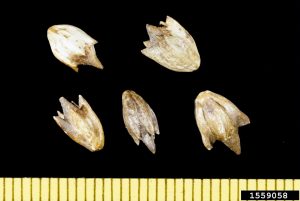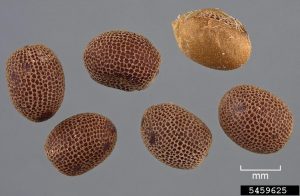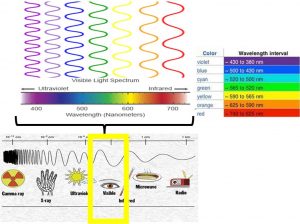Chapter 4: Seed Reproduction
4.5 Types of Dormancy Continued: Physiological
Physiological
Physiological dormancy is a bit more complicated. Different environmental effects (ie light or temperature) trigger a hormonal response that then breaks dormancy, so there is some kind of interaction happening. There are four different physiological dormancies:
- Stratification – This dormancy occurs when seeds are exposed to cool

Figure 7. Giant ragweed seed (Ambrosia trifida L.). Image from Ken Chamberlain, The Ohio State University, Bugwood.org. (32-50F), moist conditions for six to eight weeks. In other words, the common early spring conditions in the US Midwest. This type of physiological dormancy is seen in summer annuals. After these seeds go through a cool, wet spring, this environmental condition triggers plant hormones to turn on. This breaks their dormancy, allowing germination to take place. Ragweed is an example of a weed with this type of dormancy.

- After-ripening – This dormancy follows the same idea as stratification, but the other extreme of temperatures. Once seeds have been exposed to warmer conditions for six to eight weeks, the dormancy is broken and seeds can germinate. This would typically occur in the US Midwest summer months. Winter annual species can display this kind of dormancy, such as cutleaf geranium.
- Plant Hormones – The third type of dormancy is regulated by plant hormones. The biochemical pathways and triggers for these are complex, but in general:
- One hormone, gibberellin (GA), when present at a high enough level, will break dormancy in the seed and initiate germination.
- When another hormone, abscisic acid (ABA), is present at high levels, it keeps the seed dormant. Some seeds naturally have high amounts of it, and will not germinate until after the abscisic acid breaks down. As it breaks down, dormancy will end and the seed can germinate.
- Light – The fourth dormancy mechanism involves sunlight. In the following video clip, Dr. Namuth-Covert reviews light wavelengths and what this has to do with breaking dormancy, especially for small seeded plants. As you watch the clip, keep in mind that red wavelengths activate germination, while far-red wavelengths encourage seed dormancy.

Practice Activity
Complete the following drag and drop activity to learn more about weed seeds and their dormancy mechanism.
Review and Reflection